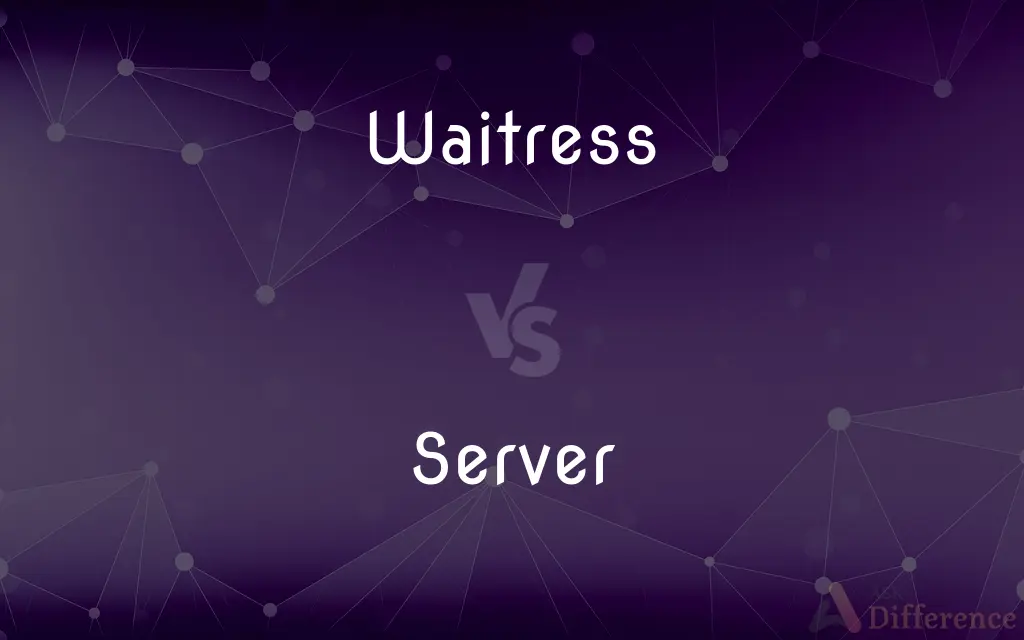Waitress vs. Server — What's the Difference?
By Maham Liaqat & Urooj Arif — Updated on March 27, 2024
A waitress is a female who serves food and drinks to customers in a dining establishment, while a server is a gender-neutral term for someone who performs the same role, regardless of gender.

Difference Between Waitress and Server
Table of Contents
ADVERTISEMENT
Key Differences
Waitress traditionally refers to a woman who takes orders, serves food and beverages, and attends to diners' needs in restaurants, cafes, and other eating places. The term is rooted in gender-specific titles common in past decades. On the other hand, server has become the preferred term in the hospitality industry, reflecting a move towards gender-neutral language and inclusivity. This shift recognizes the role's focus on service rather than the server's gender.
While "waitress" might still be used in some settings, reflecting either traditional language or personal preference, the industry's evolution towards "server" aligns with broader societal changes towards equality and nondiscrimination. This change emphasizes the professional aspects of the role over gender identity.
In terms of responsibilities, both waitresses and servers perform similar tasks, including greeting customers, taking orders, serving food and drinks, processing payments, and ensuring a satisfactory dining experience. The distinction between the terms lies more in their connotations and the move towards modern, inclusive language rather than in the nature of the work itself.
Culturally, the transition from using "waitress" to "server" also mirrors the hospitality industry's efforts to modernize workplace environments, promote gender equality, and eliminate biases. This linguistic evolution is part of a broader trend towards neutral descriptions of occupations, moving away from assumptions and stereotypes linked to gender.
The usage of "server" over "waitress" or "waiter" is encouraged in professional settings to foster an environment of respect and equality, highlighting the industry's commitment to welcoming diverse talents and providing equitable opportunities for all employees, irrespective of gender.
ADVERTISEMENT
Comparison Chart
Definition
A female who serves customers in a dining establishment.
A gender-neutral term for someone who serves in the same capacity.
Language Evolution
Traditional, gender-specific.
Modern, gender-neutral.
Industry Trend
Decreasing usage in favor of gender-neutral terms.
Preferred for its inclusivity and professionalism.
Responsibilities
Taking orders, serving food, processing payments.
Identical to waitress, without gender implication.
Cultural Impact
Reflects traditional roles.
Aligns with modern values of equality and diversity.
Compare with Definitions
Waitress
Traditionally used, now less common.
She worked as a waitress during her college years.
Server
Gender-neutral term for dining service staff.
The server was knowledgeable about the wine list.
Waitress
Female service staff at dining places.
The waitress recommended the day's special.
Server
Reflects modern, inclusive language.
Job listings now often advertise for servers instead of waitresses or waiters.
Waitress
Associated with older hospitality industry norms.
Waitresses were once the predominant term for female servers.
Server
Emphasizes service over gender.
Servers are trained to ensure customer satisfaction, regardless of their gender.
Waitress
Focuses on gender in the role.
Waitresses often wore distinct uniforms in the past.
Server
Preferred in contemporary settings.
Modern restaurants tend to use server to describe their dining staff.
Waitress
Might be preferred in certain traditional settings.
Some historic cafes still use the term waitress.
Server
Signifies industry's shift towards equality.
The use of server demonstrates commitment to gender-neutral workplaces.
Waitress
A woman who serves at a table, as in a restaurant. See Usage Notes at -ess, waiter.
Server
One who serves food and drink. See Usage Note at waiter.
Waitress
A female attendant who serves customers in a restaurant, café, or similar.
A waitress in a cocktail bar.
Server
Something, such as a tray, that is used in serving food and drink.
Waitress
(stative) To work as a waitress.
Server
An altar server.
Waitress
A female waiter or attendant; a waiting maid or waiting woman.
Server
(Law) One who serves a legal process, such as a summons or court order.
Waitress
A woman waiter
Server
(Sports) The player who serves, as in court games.
Server
A file server.
Server
A computer that processes requests for HTML and other documents that are components of webpages.
Server
(computing) A program that provides services to other programs or devices, either in the same computer or over a computer network.
Server
(computing) A computer dedicated to running such programs.
Server
One who serves.
Server
A waitress or waiter.
Server
The player who serves the ball.
Server
(Christianity) A priest's attendant at the celebration of the Eucharist.
Server
A tray for dishes.
Server
A spoon for serving food.
Server
One who serves.
Server
A tray for dishes; a salver.
Server
A person whose occupation is to serve at table (as in a restaurant)
Server
(court games) the player who serves to start a point
Server
(computer science) a computer that provides client stations with access to files and printers as shared resources to a computer network
Server
Utensil used in serving food or drink
Common Curiosities
Is it considered outdated to use the term "waitress"?
While not necessarily outdated, the use of "waitress" is decreasing in favor of the more inclusive "server."
Why has the term "server" become preferred over "waitress"?
The term "server" is gender-neutral, reflecting modern language trends and promoting inclusivity and equality in the workplace.
How has the shift from "waitress" to "server" impacted the hospitality industry?
This shift is part of broader efforts to modernize the industry, promote gender equality, and create a more inclusive environment for both staff and customers.
Can a man be called a waitress?
Traditionally, "waitress" refers to females, with "waiter" being the male equivalent. However, "server" is used for all genders.
Are there any differences in job functions between a waitress and a server?
No, the job functions are the same, involving serving customers, taking orders, and ensuring a pleasant dining experience.
Has the legal terminology in labor laws changed to reflect this shift?
In many jurisdictions, legal and industry guidelines have evolved to adopt gender-neutral language, reflecting and promoting workplace equality.
Is it offensive to use "waitress" instead of "server"?
While not inherently offensive, using "server" is more inclusive and avoids assumptions about gender roles. Sensitivity to language evolution is appreciated.
Are there any training differences for waitresses and servers?
Training for both roles is typically identical, focusing on customer service, menu knowledge, and operational procedures without distinction based on gender.
What should I use: "waitress" or "server"?
"Server" is recommended for its inclusivity and alignment with contemporary language practices, though context and personal preference can influence this choice.
Do customers perceive a difference in service quality between a waitress and a server?
Customer perceptions of service quality are generally based on the individual's performance rather than their title, emphasizing skill over terminology.
How do international restaurants in non-English speaking countries address this change?
The shift towards gender-neutral language is global, with many non-English speaking countries adopting similar changes in their languages to reflect inclusivity.
Do all restaurants and bars now use the term "server"?
While many have adopted "server," usage varies. Some places might still use "waitress" or "waiter," especially in traditional or specific cultural contexts.
Can the use of "server" impact the workplace atmosphere?
Yes, adopting gender-neutral terms like "server" can foster a more inclusive and respectful workplace culture, which can enhance team cohesion and morale.
What are some challenges in transitioning from traditional to gender-neutral job titles in hospitality?
Challenges include updating HR policies, educating staff and customers about the importance of inclusive language, and overcoming ingrained societal norms and stereotypes.
Why is gender-neutral language important in the hospitality industry?
Gender-neutral language helps create an inclusive environment, reflecting diversity and equality among staff and respecting customer diversity.
How does the use of "server" align with broader social movements?
The use of "server" aligns with broader movements towards gender equality and non-discrimination, reflecting societal progress in recognizing and respecting individual identity beyond traditional roles.
Share Your Discovery

Previous Comparison
Mentor vs. Supervisor
Next Comparison
Dolerite vs. DolomiteAuthor Spotlight
Written by
Maham LiaqatCo-written by
Urooj ArifUrooj is a skilled content writer at Ask Difference, known for her exceptional ability to simplify complex topics into engaging and informative content. With a passion for research and a flair for clear, concise writing, she consistently delivers articles that resonate with our diverse audience.















































